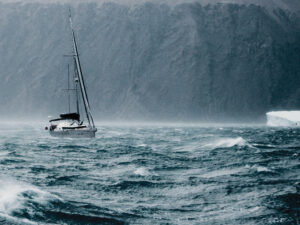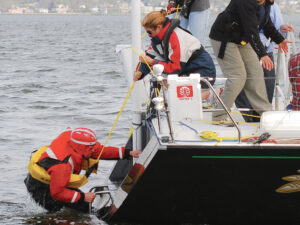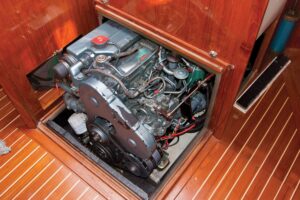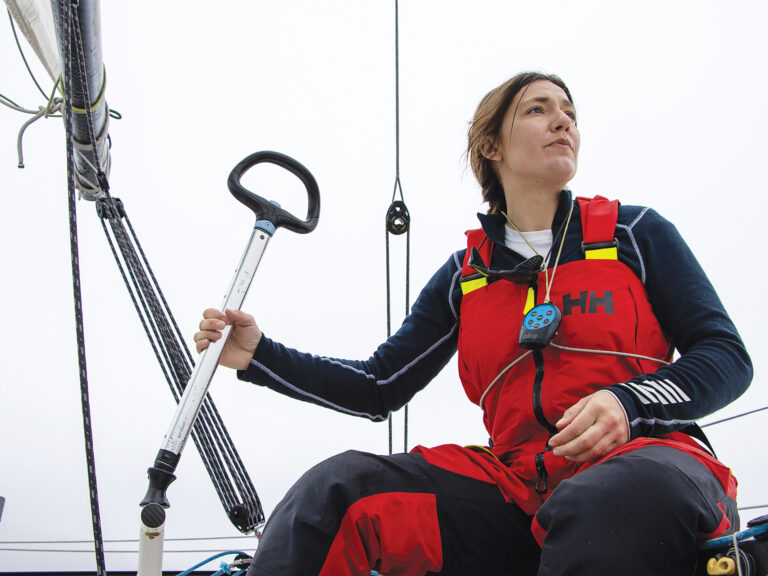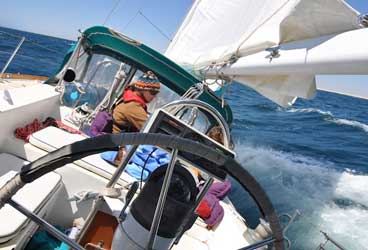
The Baja Bash
Sunday, April 22, 2012
I met Captain Jim Elfers in 1995. He stood before a blanket on the ground in a parking lot of the Channel Islands marina, in California. Like the other folks at this tiny marine swap meet, his blanket was covered with used boat detritus. But there were also a couple spiral-bound, pre-publication copies of a book he had just written: The Baja Bash. Drawing on the experience he gained delivering more than 20 boats up the Baja coastline from Cabo San Lucas to San Diego, Elfers wrote The Baja Bash to provide very specific advice on how to best approach this passage. He dedicated his book to, “the lone American who, upon driving to McDonalds and spilling coffee on himself, curses his clumsiness and drives away without calling a lawyer.” I bought a copy. Seventeen years later, a second edition is still in print.
In the first few pages, Elfers makes it clear that April, May, and June are the worst months to make this trek. “If you want San Diego…you’ll have to earn it.”
The Baja is a narrow, 800-mile-long peninsula. On one side are thousands of miles of cold, Pacific Ocean. On the other side is the warm body of the Sea of Cortez. This unique geography results in a strong, predictable seabreeze cycle. Added into the mix are cape effects, wind belts, and funnel effects that occur along this coastline. Nearly every likely climactic condition and sea state favors a southbound route.
In fact, you often hear folks claim that the trip from San Diego to Cabo San Lucas is so easy that anyone can make it on a 55-gallon drum. Of course, this means it is an inherently difficult passage when heading the other direction. And there are few resources or refuges along the way. The two Mexican states that comprise the peninsula are the least populated of all Mexican states. You are on your own.
For the past few months, every time we’ve talked to another sailor about our plans to head to the Pacific Northwest from Mexico, they’ve asked us whether we are taking the easier, more accepted route, via Hawaii. When we’ve said we’re not, that we have friends and family we want to visit along the way, up and down the West Coast, I could see what they are thinking, “Sucks to be you.” And they usually verbalized this thought.
In The Baja Bash, Elfers says that, “many of the first-time Mexico returnees I’ve spoken to put their boats up for sale the minute they hit San Diego.” He stresses the importance of timing the rounding of Cabo Falso, just a few miles north of Cabo San Lucas. Here is where thousands of miles of uninterrupted Pacific wind, wave, and current convergence meet the 200-mile wide mouth of the Sea of Cortez. “…Falso gets a cape effect that can be awesome to behold.”
We left Cabo San Lucas for Cabo Falso the morning of Friday, the 13th of April–and we beheld it.
Ignoring the fact that we began our trip on a Friday (a sailing taboo—and Friday the 13th, no less), we picked nearly the worst conditions to head north from Cabo San Lucas: persistent northwesterlies.
Why did we do this?
To every person who expressed pity when we told them we were Bashing this year, my optimistic response was uninformed and foolish. “Ah heck,” I’d say, “of course the Bash is not a downwind sail, but we don’t mind tacking upwind, covering some extra miles and taking some more time. We’ll get there.” I’d reasoned too that the bad reputation was probably exaggerated. After all, it probably stems from the stories of frustrated delivery captains who are paid by the trip and want to finish as quickly as possible. We had time. Windy and I knew the first 40 miles, to get ourselves around Cabo Falso, would be difficult. But surely there was not a need to wait for the wind to die completely so we could motor north.
We confidently left Cabo in the early morning with 20 knots blowing around the cape.
We got smacked. It was rough. We tacked out on a west-northwesterly heading with a reefed main and full jib.
After half a day, it got rougher. We reefed the jib. By late afternoon, it got rougher. We furled the jib and started the motor.
Under reefed main and motor we pounded and pounded into increasingly large, steep, and confused seas. We should have turned around, but figured we would not have to endure too much more. Surely these conditions were specific to the Cape. After all, the wind was completely manageable under reefed sails, we just had to get past these damn seas.
Into the evening, it seemed we were constantly grinding to a halt after slamming into a steep wave or being broadsided by another. Our speed continued to deteriorate. The sound down below was awful and we learned about all of the things we had not stowed well. The pitching was so bad it swung the glass chimney of our oil lamp into a mirror, shattering it.
During the first night, we tacked again out to sea, hoping for more regular seas 30 miles out. Nobody ate anything. Nobody could sleep well. It was the first of three long nights.
Both of us were surprised when the first, heavy blast of cold sea water blew over the coaming and into the cockpit. Our boat has a lot of freeboard and the cockpit is perched high above the aft cabin. This makes for a dry boat. We’d before seen only the rare wisp of spray reach the foredeck, but never sheets of water in the cockpit, not until now. I was drenched and cold. We dug out our warm clothing and foul weather gear, stowed since we left Washington, D.C. almost a year ago.
By the second day, the drenching seawater dousing in the cockpit was constant. A couple times heavy gusts overpowered our reefed main to bury the toe rail. Yet northwestward progress remained depressingly slow. We spent our on-watch hours hanging out under the dodger and down below, making quick trips outside only to alter course or check the engine gauges. We continued on.
About this time, Windy noticed the bilge pump was running intermittently. She dutifully reached down and tasted it: saltwater. Our bilge incorporates a deep sump with an opening of about 20 inches by 20 inches. My theory was that the small amount of water in this sump was sloshing, repeatedly activating the float switch. We turned off the bilge pump to test the theory. An hour later, the primary pump was underwater and the secondary pump was about to be triggered. The pump ran for 30 seconds when we turned it on.
With all of the water we were shipping on deck over the bow, I guessed that the source of our bilge water was the two hawse pipes forward. I climbed to the head of the v-berth and removed the access panel to peer into the anchor locker with a flashlight, bracing myself against the constant and often violent pounding, rolling, and pitching. It appeared that every 15 seconds at least two cups of water would pour down from the two hawse pipes. Windy added “plug the hawse pipes” to our departure checklist.
Toward the end of the same day, Windy called me to the aft cabin. She pointed to water seeping and pumping out from behind the cabinetry and over the floor boards. Hawse pipe water ingress could not rise to this level. There was no tankage aft. Yet saltwater was coming from behind the cabinets, onto the floorboards, running forward into the main cabin and finding its way down to the bilge. This didn’t look good. To our credit, we both tend to stay pretty calm under pressure.
I pulled up the soaked cushion over the bench between the two aft berths. In the locker underneath, the group 31 starting battery was nearly underwater. With the locker open, water now sloshed out and into the main cabin, a half-gallon with each roll. Using a hand pump, Windy and I removed five gallons from this space. The water returned slowly.
This water was coming from someplace aft and above the engine and prop shaft seal. The only potential failure points I could think of this far aft are the cockpit drain through-hulls and the rudder post, both accessed only via the lazarette. My mind skipped ahead to the worse-case scenario for the water intrusion: a crack in the hull where the rudder post exits, a potentially catastrophic failure. This scenario seemed unlikely, especially as our rudder hangs from a full strut, but it is a point of rare failure on sailboat hulls and I couldn’t help but dwell on what seemed to be extreme forces we’d subjected 34-year-old_ Del Viento_ to over the past 36 hours. Our pitching and rolling hadn’t been smooth and pleasant, it had seemed course, our hull slammed from the side and falling off the top of steep waves and into deep troughs, crashing, over and over, non-stop.
Out in the cockpit, I began to empty the lazarette. I had to clear it to access and remove the floor boards to check the rudder post and cockpit drain through-hulls—I was soon shaking cold and wet. Where the heck was I going to put our life raft, four five-gallon jerry jugs, two sails, four fenders, a huge duffle bag of line, kayak oars, a shovel, two folding chairs, a dolly, a large emergency rudder, heavy wind vane components, and other things?
I worked quickly and neatly, securing and ordering things in the cockpit. I was halfway through when I realized everything I pulled out was drenched. I could hardly lift the duffle bag of line, soaked through as it was. I realized what was happening. Even as I worked, deck water rushed aft and gushed over the shallow coaming and into the lazarette. Water entering at this point had been a problem in the past. Even in a slip with heavy tropical rain and the lid secured, deck water that found its way aft would pool and flood below through this lazarette lid. I’d forgotten all about it as it has hardly rained since we moved aboard in September.
More water poured in. Good. I didn’t continue emptying the lazarette. I put everything back, relieved.
Later, Windy was in the cockpit when the Harken main sheet traveler car ran out to leeward. The shackle that attaches it to the windward side sheared off under load. She determined that none of our spare shackles were a good fit and improvised a fix using a strop of Spectra our friend Ethan (Eyoni) made and gave us before we left.
Then it was my turn: I noticed our radar tower moving like it hadn’t before, swaying in increasing arcs. This is the robust, three-inch diameter, aluminum pole at the stern used to mount the radar, cockpit light, stern nav light, shortwave radio antennae, and wi-fi antennae. This pole is attached below decks with lag bolts into wood blocks that are glassed to the hull. From here the pole passes through the deck and extends 10 feet above the deck. Halfway up is a davit that extends outward for raising and lowering our 85-pound dinghy motor with block and tackle.
The bolts that attach the pole at the base and to the deck collar sheared. I secured the pole with half-inch line to cleats forward and athwartships before it could do further damage.
By the time we reached Bahia Magdelena, 125 miles north of Cabo, the wind and seas had abated as forecast and we’d enjoyed six hours of relative calm. Windy was sleeping like a log. We anchored just inside the bay and I crashed too. The boat was a disaster down below. Later that day we woke and motored 15-miles up the bay to the fish processing plant at San Carlos to buy some diesel for_ Del Viento_ and ice cream for the girls. This calm was the start of the weather window that would have allowed us to motor sail quietly around Cabo Falso and north.
I grew up in an era where everything seems to be exaggerated. If you take the televised evening news literally, you will turn into a frightened, cynical person with an unrealistic perception of the risks inherent to living. I learned to be critical. Perhaps that is why I discounted in this case, advice rooted in common sense. I discounted expert testimony in The Baja Bash. I know too that I felt that we didn’t buy a sailboat so that we could motor up the Baja. Why wait for a weather window so I could motor instead of sail? Now I know the answer. When we anchored at Mag Bay, we’d run the engine 54 hours since Cabo. Ironically, we’d have run the engine for fewer hours had we waited for a weather window and planned to motor the entire route direct.
In the end, Del Viento and her crew faired pretty well. We put the shake back into the shakedown cruise and found some valuable surprises, but nothing really disappointing. Frances threw up once and the rest of us suffered bumps and bruises, but otherwise we are all happy and healthy. We have more confidence in Del Viento and we do not plan to put her up for sale in San Diego. But that could change, we still have 675 miles to go.
–MR
_I__n our twenties, we traded our boat for a house and our freedom for careers. In our thirties, we slumbered through the American dream. In our forties, we woke and traded our house for a boat and our careers for freedom. And here we are. Follow along at _

